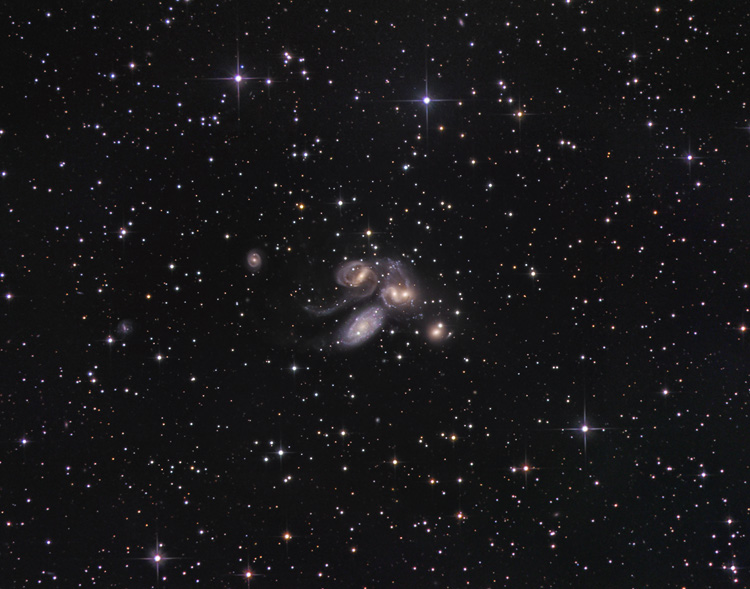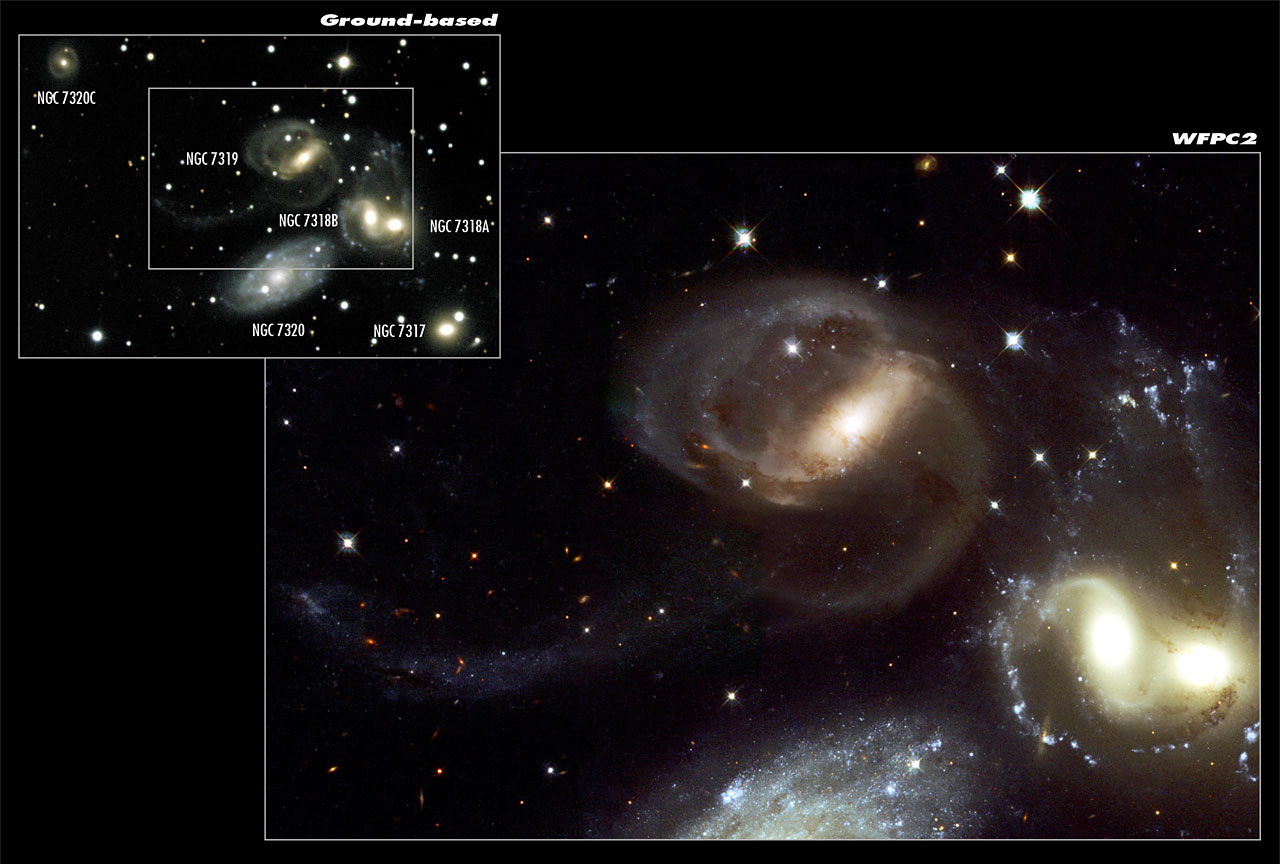APOD: The Universe Nearby (2011 Jun 14)
-
Sgt. Bilko
Re: APOD: The Universe Nearby (2011 Jun 14)
Here's a link to an image of the crab nebula - To me, the structure represented by the images seem similar....
http://apod.nasa.gov/apod/image/0910/cr ... st_big.jpg
http://apod.nasa.gov/apod/image/0910/cr ... st_big.jpg
-
Quigley
Re: APOD: The Universe Nearby (2011 Jun 14)
So if we estimate the age of the universe, what was there before that and for how long? And before that? If we can only see the observable universe, what's outside of that? How big? And outside of that? Makes you think of the eternal...that there is eternity. How very small we are in so many ways.
- Chris Peterson
- Abominable Snowman
- Posts: 18187
- Joined: Wed Jan 31, 2007 11:13 pm
- Location: Guffey, Colorado, USA
- Contact:
Re: APOD: The Universe Nearby (2011 Jun 14)
Most physicists would argue that the idea of "before" the Universe has no meaning- or at least, the meaning is very different from what we intuit "before" to mean, for the simple reason that we presume that the beginning of the Universe also defines the beginning of time itself.Quigley wrote:So if we estimate the age of the universe, what was there before that and for how long? And before that? If we can only see the observable universe, what's outside of that? How big? And outside of that? Makes you think of the eternal...that there is eternity. How very small we are in so many ways.
As far as how big the Universe is (that is, the entire thing, not just the observable Universe) the value is exquisitely sensitive to some poorly constrained initial conditions, so estimates range from just a few times larger than the observable Universe to infinite. Still working on that one <g>.
Chris
*****************************************
Chris L Peterson
Cloudbait Observatory
https://www.cloudbait.com
*****************************************
Chris L Peterson
Cloudbait Observatory
https://www.cloudbait.com
Re: APOD: The Universe Nearby (2011 Jun 14)
I have to say something about Halton Arp. He used to be a very, very interesting astronomer, indeed a brilliant one. He asked questions that forced the astronomical society to come up with palusible answers, and that is always a very good thing.
However, Halton Arp was at his best when his questions were harder to answer. He says that redshift doesn't indicate distance. One of his famous examples was Stephan's Quintet. Earlier, when telescopes and observational techniques were much less advanced than today, it was much easier to think that all the galaxies in Stephan's Quintet are at the same physical distance:
Read about the picture here: http://panther-observatory.com/gallery/ ... Q_cass.htm
However, today Hubble and other telescopes have showed us that one of the galaxies in Stephan's Quintet, NGC 7320, is indeed much closer to us than the other ones. That is why its redshift is very different from the redshift of the other galaxies in Stephan's Quintet: precisely because NGC 7320 is so much closer to us.
NGC 7320 is at the bottom of this picture. Note how well resolved it is, precisely because it is nearby.
Ann
However, Halton Arp was at his best when his questions were harder to answer. He says that redshift doesn't indicate distance. One of his famous examples was Stephan's Quintet. Earlier, when telescopes and observational techniques were much less advanced than today, it was much easier to think that all the galaxies in Stephan's Quintet are at the same physical distance:
Read about the picture here: http://panther-observatory.com/gallery/ ... Q_cass.htm
However, today Hubble and other telescopes have showed us that one of the galaxies in Stephan's Quintet, NGC 7320, is indeed much closer to us than the other ones. That is why its redshift is very different from the redshift of the other galaxies in Stephan's Quintet: precisely because NGC 7320 is so much closer to us.
NGC 7320 is at the bottom of this picture. Note how well resolved it is, precisely because it is nearby.
Ann
Color Commentator
- alter-ego
- Serendipitous Sleuthhound
- Posts: 1120
- Joined: Mon Apr 21, 2008 4:51 am
- Location: Redmond, WA
Re: APOD: The Universe Nearby (2011 Jun 14)
Because Dark Energy is such a hot topic, I think it's worth adding that cosmologists do value distance indicators, as there are several, for testing different cosmology models. In particular, DE is a direct outcome of measuring space curvature by plotting essentially red-shift distance verses the luminosity distance for the Type 1a sn.Chris Peterson wrote:There is some kind of meaning there, but perhaps it isn't so useful. Cosmologists generally look at z, the redshift, as the fundamental unit, and it isn't usually felt necessary to convert this to a distance- except in press releases <g>.NoelC wrote:...then is it really meaningful to think in terms of distance?
A pessimist is nothing more than an experienced optimist
-
Mactavish
Re: APOD: The Universe Nearby (2011 Jun 14)
Gee guys... sorry I asked! After reading the subsequent posts, I feel like the guy who started a fight in a bar, then ducked out the back door to watch the action through the window. Every evening I open APOD and a beer. That's been a lot of wonderful astronomy pictures (and a lot of beers) over the past 15+ years. Keep `em coming!
- DavidLeodis
- Perceptatron
- Posts: 1169
- Joined: Mon May 01, 2006 1:00 pm
Re: APOD: The Universe Nearby (2011 Jun 14)
The explanation states "each dot represents a galaxy". There are a lot of dots, so lots of galaxies out there which is utterly mind boggling! Our Universe sure is a big place yet, as far as I understand, most of it is empty space!
I liked that the "evolved" link brought up an abstract of a paper of which Robert Nemiroff (one of the APOD editors) is a joint author.
I liked that the "evolved" link brought up an abstract of a paper of which Robert Nemiroff (one of the APOD editors) is a joint author.
Last edited by DavidLeodis on Wed Jun 15, 2011 2:28 pm, edited 1 time in total.
- neufer
- Vacationer at Tralfamadore
- Posts: 18805
- Joined: Mon Jan 21, 2008 1:57 pm
- Location: Alexandria, Virginia
Re: APOD: The Universe Nearby (2011 Jun 14)
The map is showing redshift z, which (for these small values) is a ratio of the apparent recessional velocity to c- a unitless value.Chris Peterson wrote:The map is not really showing a percentage of c. That would be a velocity.NoelC wrote:
I like that this map is presented in % of C as opposed to trying to describe things in terms of distance.
The map is showing redshift, which is a ratio of the apparent recessional velocity to c- a unitless value.
[c]z/(1+z) = apparent recessional velocity to c[/c]
Art Neuendorffer

